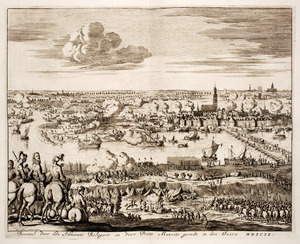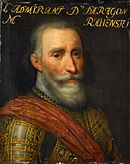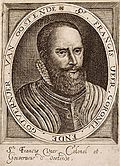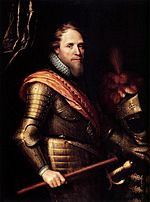Siege of Zaltbommel facts for kids
Quick facts for kids Siege of Zaltbommel |
|||||||
|---|---|---|---|---|---|---|---|
| Part of the Eighty Years' War & the Anglo–Spanish War | |||||||
 Siege of Zaltbommel by the Spanish in 1599 by Hugo Grotius |
|||||||
|
|||||||
| Belligerents | |||||||
| Commanders and leaders | |||||||
| Strength | |||||||
| 12,000 | 12,000 | ||||||
| Casualties and losses | |||||||
| 500 | 2,000 | ||||||
The Siege of Zaltbommel was an important battle during two big wars: the Eighty Years' War and the Anglo–Spanish War. It happened from May 15 to July 22, 1599. Spanish forces, led by Francisco de Mendoza, tried to capture the area around Bommelerwaard in the Netherlands. However, Dutch and English soldiers, commanded by Maurice of Orange, defended the region.
The Spanish tried to surround and attack the town of Zaltbommel. But they had to give up their attack. They were defeated in later attempts to win back control. Mendoza and his army had to retreat. This caused big problems for the Spanish army, including soldiers refusing to fight (called mutinies). Because of this, they couldn't plan any more attacks for a few years. This allowed the Dutch and English to launch their own attacks in the Spanish Netherlands.
Why Zaltbommel Was Important
In 1572, the city of Zaltbommel decided to become independent from Spanish rule. It joined forces with the "Sea Beggars," who were Dutch rebels. Because of this, Zaltbommel became a target for the Spanish. They even tried to attack it to distract from another battle at Leiden. But Zaltbommel held strong.
Over the next ten years, the Dutch, led by Maurice of Orange, took control of the area. Even though the Spanish tried to fight back many times, they usually lost. Zaltbommel was a very important city for the Dutch. It was a strong border fortress. Maurice knew how vital it was. So, starting in 1580, the city's defenses were made much stronger. New walls and forts were built. Maurice also made sure the city had plenty of food and supplies for both soldiers and citizens.
To help with defenses, temporary bridges were built. These allowed troops and supplies to easily get into the city. The Spanish wanted to take back all the land they had lost. This made Zaltbommel a key target.
In April 1599, the Spanish army in Gelderland, led by Francisco de Mendoza, was ordered to attack Bommelerwaard. If they took this area, they could cut off Holland. Mendoza's army, with 12,000 soldiers, tried to capture a fort called Schenkenschanz. But the English soldiers defending it fought them off. At the same time, Maurice's main Dutch and English army, with 10,000 foot soldiers and 3,000 horse soldiers, moved quickly to stop the Spanish. They traveled mostly by boat to arrive fast.
The Battle Begins
On May 4, after failing to take Schenkenschanz, the Spanish army moved around the fort. They crossed the Meuse river and entered the Bommelerwaard area. More Spanish troops arrived. They quickly captured Fort Crèvecoeur, which was blocking their way. Then, the siege of Zaltbommel officially began.
Maurice quickly gathered his forces inside and around Zaltbommel. They built strong defenses. He also sent a group of soldiers to hold the town of Alst. Two days later, the Spanish attacked the defenses around Zaltbommel with great force. But the attack was pushed back, and the Spanish lost many soldiers.
Even with these losses, Mendoza kept trying to get closer to the city. His soldiers dug trenches and set up cannons. Small fights happened every day. But the Dutch and English were ready. They used the river to their advantage. They sent 280 boats, some with cannons, to help. On land, 379 wagons brought supplies, and 356 horses were gathered to pull the cannons.
On June 13, Maurice's cannons fired heavily on the Spanish camp. This forced the Spanish to stop their attack on Zaltbommel. Mendoza hoped this would only be a short break. He moved his army across the island and started building a huge new fort. This fort, named San Andres, was built in honor of Mendoza's friend. Maurice tried to stop the building of Fort San Andres by firing cannons at it. But the Spanish kept building. They made five strong sections with walls connecting them. The rivers acted like a protective ditch. Maurice set up his cannons on the other side of the river, and there was a lot of cannon fire. But for many days, both armies were mostly quiet.
On June 24, a group of soldiers led by Count William Louis of Nassau and Sir Horace Vere crossed the river. By morning, they had built a crescent-shaped defense at Heerewaarden, close to Fort San Andres. The next day, 3,000 Spanish and Italian soldiers attacked this defense. They broke through the fences and fought hand-to-hand. But Vere, with help from a Scottish Colonel named Edmunds, held the position. The Spanish were eventually forced back, losing many soldiers. A Scottish colonel named Murray, an old soldier, was killed when the English and Scots launched a successful counter-attack after the Spanish ran away.
Maurice then decided the best way to help Zaltbommel was to build a bridge. This bridge would connect Heerewaarden with Voorn. Maurice's engineers used fourteen flat-bottomed supply ships. They removed the sails and anchored them in a line across the Waal river. They then built a wooden road across the ships. It was wide enough for two wagons to pass. Soon after, a protected position was built at Lithoijen to guard the bridge. Supplies then flowed into the city. This bridge was a huge advantage for the Dutch and English.
To stop the Spanish from reaching the bridge and surrounding Zaltbommel from the west, Maurice ordered the dikes near Gameren to be broken. This flooded the countryside. Soon after, Sir Francis Vere crossed the river with 6,000 men. He then successfully attacked a Spanish position. This attack put the Spanish in danger of being completely cut off.
This was too much for the Spanish soldiers. Their spirits dropped. Mendoza and his second-in-command argued openly about who was in charge. Soldiers weren't paid or fed well, and many had poor weapons. More and more soldiers left every day, and there were rumors of mutiny. Mendoza's problems grew, and he realized Zaltbommel could not be taken. He ordered a retreat from Bommelerwaard. When the Dutch and English heard the Spanish were leaving, they attacked the old Spanish positions around Zaltbommel. They took weapons, and found women, children, and sick prisoners in the abandoned Spanish camp. Most were soon released.
By July 22, Mendoza had retreated, losing 2,000 men. This meant a complete victory for the Dutch and English. With the Spanish gone, Maurice then attacked several places in eastern Bommelerwaard that Mendoza had taken. Doetinchem was recaptured by William Louis on August 25, 1599.
What Happened Next
With the siege over, Maurice had cleared the Spanish from all of Bommelerwaard. The Spanish wouldn't try any more attacks there for the rest of the year. Before he left, Mendoza placed 3,000 men inside Fort San Andres. But less than a year later, these soldiers were surrounded by the Dutch and English. They mutinied (refused to fight) and were sold to Maurice in exchange for their unpaid wages.
The entire campaign in Bommelerwaard was a huge failure for the Spanish. It was a big blow to their plan to expand their territory north of the Mass river. After the campaign, Vere reported that the Spanish army was so tired and unhappy that soldiers were "leaving in groups." There was little hope of them fighting well until their leader, the Archduke, returned. Even worse, a series of mutinies meant that the Spanish had to stop all further operations. This allowed the Dutch and English armies to launch their own attacks.
The next year, the Dutch government saw the chaos in the Spanish army. They decided it was the perfect time to focus the war on Catholic Flanders. Johan van Oldenbarneveldt, a key Dutch leader, ordered Maurice to take the fight there. Maurice agreed, even after some arguments. Maurice's army, with a large group of English soldiers led by Francis Vere, used the city of Ostend as a base to invade Flanders. Their goal was to capture Dunkirk, a city known for its privateers (pirates working for a government). In 1600, they marched toward Dunkirk. In a major battle, the Anglo-Dutch forces defeated the Spanish army at the Battle of Nieuwpoort. The English played a big part in this victory. Even though they didn't capture Dunkirk, the Anglo-Dutch forced the Spanish away from the heart of the Dutch Republic. This helped them secure important towns while the Spanish were busy with the siege of Ostend.
See also
 In Spanish: Asedio de Zaltbommel para niños
In Spanish: Asedio de Zaltbommel para niños





